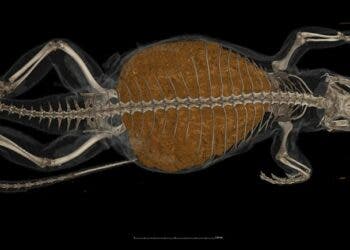
Nature is often riddled with paradoxes. On the one hand, you have species that expend a great deal of energy to embellish their appearance to attract mates or to communicate with peers. On the other hand, the same traits can make these individuals sitting ducks to predators. It’s on this tightrope, anchored by natural selection on one end and sexual selection on the other, that many species dance.
However, this is an oversimplification. New research from the University of New South Wales (UNSW) shows that standing out in appearance doesn’t necessarily invite predators for dinner. In fact, as the field experiments showed, being too flashy may actually dissuade predators.
For their study, the researchers led by Terry Ord, an evolutionary ecologist and Associate Professor at UNSW’s School of Biological, Earth and Environmental Sciences, placed a staggering 1,566 robotic lizards on trees on the campus of a university in Borneo.
The robot consisted of a box filled with motors and microelectronics, on top of which sat a plasticine draco lizard that was cast out of a realistic model. The robots performed one of three functions: a conspicuous visual display, a conspicuous ornament, or remained cryptic. The latter acted as a negative control, in that the researchers assumed that this state would be least predated by the many birds, cats, and snakes around the campus. The putty-like plasticine is great for assessing predation because you can clearly see all the pecking, biting, and scratching left by attackers.
Draco lizards are known as ‘gliding lizards’, as they have retractable gliding membranes. They communicate with extendable throat-fans, called dewlaps, which are diverse in color, shape, and size among species. Ord fitted a colorful plastic gliding membrane to each of the many robot lizards that littered the trees at the Kota Samarahan campus in Borneo, which was displayed or retracted at regular intervals by a servo motor controlled a micro-controller, mimicking real draco behavior.
Ord and colleagues embarked on this research looking for clues as to how exactly visible predator warning systems evolve in prey systems. Some animals employ bright, contrasting colors, such as the black and yellow of many wasps and the red of ladybird beetles — a phenomenon known as aposematism — as if to advertise ‘I’m not good to eat. Moreover, if you do decide to eat me, you will die in horrible pain!’
But, you see, this is a chicken or the egg dilemma. How did predators know to avoid these prey that displayed warning systems in the first place?
“There’s a paradox, when the first prey evolves a conspicuous signal, the predators are not going to know what that signal is about, the prey are going to get attacked, and they’re not going to reproduce to pass their genes onto the next generation,” Ord told Cosmos Magazine.
“How do you actually get from point A – that’s being cryptic and hiding – to point B, which is being conspicuous and deliberately advertising that you’re not profitable to predators.”
Instead of finding that the flashiest draco lizard decoys had their heads chopped off in overwhelmingly large numbers compared to controls, the researchers actually found that “robotic prey that performed a conspicuous display were equally likely to be attacked as those that remained cryptic.” Furthermore, predators avoided attacking robotic prey with a fixed, highly visible ornament, the researchers noted. In other words, the oddest animals were visited by predators the least.
Ord and colleagues refer to the deterrence of predators by stand-out features as “predator conservatism”, challenging the entrenched notion that conforming prey that looks like everyone else makes the animal safer.
The findings appeared in the journal Proceedings of the Royal Society B.






